Density and fluctuations of a nest-pocket breeding population of the Treecreeper Certhia familiaris over a 28-year period
DOI:
https://doi.org/10.34080/os.v24.22562Keywords:
breeding success, population studies, climate effects, habitat selection, climate change resilienceAbstract
The number of breeding Treecreeper pairs was estimated from 1982 to 2009 in a 2.7 km2 study area located in south-western Sweden (57°39'N; 12°4'E). Most of the area, which was provided with 205 man-made nest pockets, is covered by broad-leafed forest. The number of first clutches varied between 5 and 21 with an annual average of 14±4.2 (SD) breeding pairs (CV 30%). The density of breeding Treecreepers varied from 1.9 to 7.8 pairs/km2 with a mean of 5.1±1.86 pairs/km2. The population did not show any statistically significant density trend over the 28 years. The between-year variation in the return rate of ringed adult females that bred after wintering was significantly negatively related to the temperature and precipitation means of the preceding winter. Thus, fewer females returned after milder winters with higher precipitation. The statistical tests pertaining to the variation in the whole breeding population indicate that the species can cope with moderate fluctuations in winter weather, thus preventing significant changes in the number of breeders in the study area.
Downloads

Downloads
Published
How to Cite
Issue
Section
License
The copyright of each contribution belongs to the author(s), but all contributions are published under a Creative Commons license, so that anyone is free to share and reuse the contribution as long as the copyright holder is attributed.







